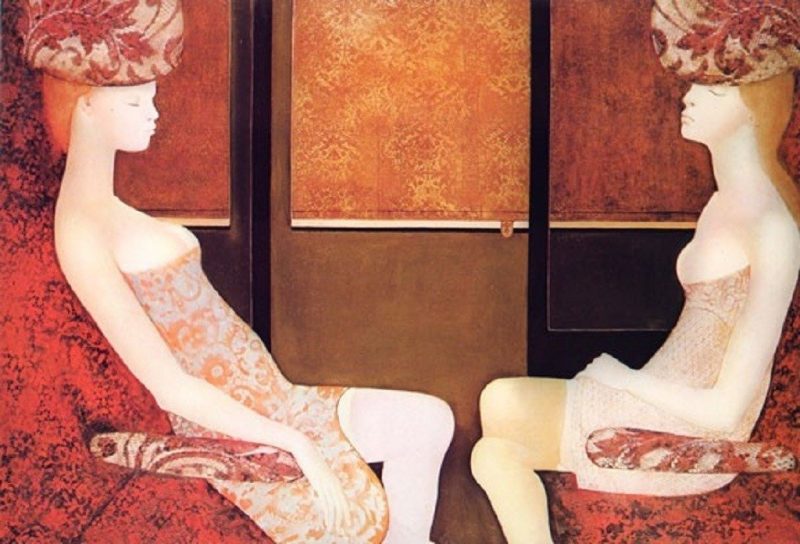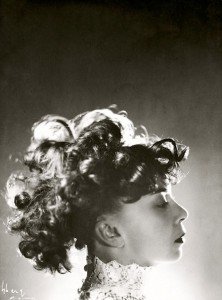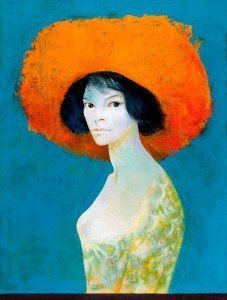 [leggi l’articolo in italiano] “I paint pictures that do not exist and that I would see” (“Le livre de Leonor Fini”, 1975)
[leggi l’articolo in italiano] “I paint pictures that do not exist and that I would see” (“Le livre de Leonor Fini”, 1975)
With this quote we introduce a great artist of the twentieth century: Leonor Fini. The art critic Vittorio Sgarbi believes that Leonor is “the painter capable of representing the feminine with a very special sensitivity”
(Article: Vittorio Sgarbi: the beauty and art)
But who it is really Lolò?
Oscar de Mejo: “Lolò, was called within her family … But the real name was Leonora … which became Leonor, indeed Leonor in French”. (from the Roberto Curci’s book “I married Alida Valli”).
Lolò was an innovative, revolutionary, nonconformist woman. A comprehensive emblematic figure. Friend of many artists of the twentieth century, she knew the group and the Surrealists and with Max Ernst had a little affair – one of the many men with whom she undertook a brief love affair. Defined her as a Surrealist painter, but she did not know it.
During her life many photographers portraied her: Lee Miller, Henri Cartier-Bresson, Dora Maar, Man Ray, Horst P. Horst, Erwin Blumenfeld, Arturo Ghergo, Cecil Beaton, André Ostier, Eddy Brofferio, Richard Overstreet – and many others.
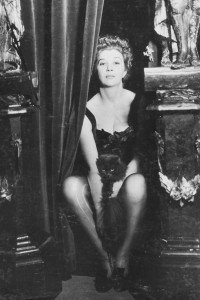 She loved to be photographed, loved her image and adored attending costume parties that in the years fifties and sixties were all the rage in Venice, Monte Carlo and Paris. At parties she did not like to dance, she loved just show up and dressed well, be photographed and then return home. She liked to show off.
She loved to be photographed, loved her image and adored attending costume parties that in the years fifties and sixties were all the rage in Venice, Monte Carlo and Paris. At parties she did not like to dance, she loved just show up and dressed well, be photographed and then return home. She liked to show off.
She was not an actress, but interested in the inevitable theatricality of life:
“When I was a child, I hated be photographed. I fled. As a Muslim, I covered my face. Gradually, I found interesting to have a face: confirmation of my existence. […] Since then I have always been photographed: masquerade, disguised, daily. But I do not like snapshots, nothing is further from the truth as the “naturally” fixed. It is the “pose” that is revealing, and I am curious and amused to see my variety.” (“Le livre de Leonor Fini”, 1975)
 So the act of disguise, for Leonor, was the basis of everything, and as she recalls: “Dressing up is the tool to get the feel of changing dimension, type and space, “and again” masquerade, disguise is an act of creativity. And if you apply it on yourself you can become other characters or stay in character. The fact of dressing up is a multiplied vanity, because to get inside other images makes the show even more fascinating and even if you are in a kind of trance, at the end of the day you are always yourself. ” (“Le livre de Leonor Fini”, 1975)
So the act of disguise, for Leonor, was the basis of everything, and as she recalls: “Dressing up is the tool to get the feel of changing dimension, type and space, “and again” masquerade, disguise is an act of creativity. And if you apply it on yourself you can become other characters or stay in character. The fact of dressing up is a multiplied vanity, because to get inside other images makes the show even more fascinating and even if you are in a kind of trance, at the end of the day you are always yourself. ” (“Le livre de Leonor Fini”, 1975)
The Leonor Fini painting was truly unique and inimitable. In an interview in 1994 for the RAI in Friuli Venezia Giulia, the artist recalled: “In painting one does, there is the specific intention, but also something underneath, which it is formed by all the past things that have a big intrigue. They are memories of what you have not noticed in a precise way, but which remain in us and take different aspects. I can not talk about my painting, unless I start invent.”
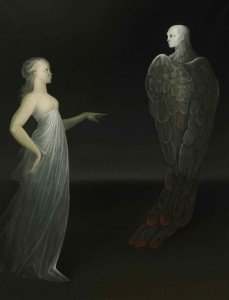 While, in her autobiography, wrote: “Sometimes I say that I paint pictures that I would like to see and that do not exist. But it is a joke, because the path of my painting is actually unknown to me as to the beholder. Knowing that it is about me, myself, I can naively imagine to have detected a visible sign that could be this or that; my intuition or deduction might be right, but sometimes I also might suspect the opposite.
While, in her autobiography, wrote: “Sometimes I say that I paint pictures that I would like to see and that do not exist. But it is a joke, because the path of my painting is actually unknown to me as to the beholder. Knowing that it is about me, myself, I can naively imagine to have detected a visible sign that could be this or that; my intuition or deduction might be right, but sometimes I also might suspect the opposite.
Basically it does not concern me. What is sure, it is that I would love that the paintings will appear as close each other. I want them painted as well as possible […]I like the act of painting, it gives me pleasure, concentration, intensity: a charge like happiness, ” like the dancing, singing give to the others… [art] I think it is an activity connected to the ancient origins.
Her paintings had a parodic side, dramatic and seductive elements; They are ambiguous and mysterious. Human figure was fundamental and important to Leonor; she had never been attempted by making abstract things. “The human being is the protagonist of our lives”.
You could not classify Fini as a Surrealist artist, because she was much more. We limit ourselves in this first space that dedicate to her only to trace, as far as possible, the most important and significant phases of her life.
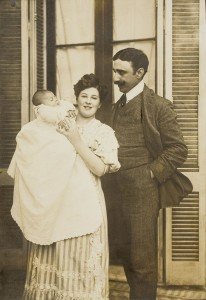 Leonor Fini was born on 30 August 1907 in Buenos Aires – the city of her father Erminio, who originally come from Benevento. At two years she moved with his mother to Trieste by sea. Her mother, Malvina Braun, left her abusive husband and went to live with her daughter by her parents – the Leonor’s grandmother is dalmatian, while the grandfather was from Sarajevo. Several times the father attempted to kidnap Leonor: her mother dressed her as a boy then, so as to be unrecognizable.
Leonor Fini was born on 30 August 1907 in Buenos Aires – the city of her father Erminio, who originally come from Benevento. At two years she moved with his mother to Trieste by sea. Her mother, Malvina Braun, left her abusive husband and went to live with her daughter by her parents – the Leonor’s grandmother is dalmatian, while the grandfather was from Sarajevo. Several times the father attempted to kidnap Leonor: her mother dressed her as a boy then, so as to be unrecognizable.
When they got home at the mother’s parents, located in Via di Torre Bianca – between Via Carducci and the Canal – Leonor saw for the first time a white cat which fascinated her and with whom became friends. The little Lolò lived with her grandparents, mom and uncle Ernesto Braun. Her mother was very proud of her. Already as a child, Leonor drew well and at four years she taokpart in a painting competition and won the first prize for drawing a chicken lying a egg casserole. “The thing I liked most was to have many colored pencils and drawing” – recalls Lolò – “… House of my childhood, Gallé vases, libraries full of books, the smell of cinnamon in the corridors. On the walls of the hall I have seen this print by Franz von Stuck. (A woman wrapped in a snake n.d.s) As soon as I learned to read, I asked what meant “Sinnlichkeit”, which was written below. They answered, ‘the Sensuality’. And what does it mean: the Sensuality? Invariably the answer was “die Sinnlichkeit”
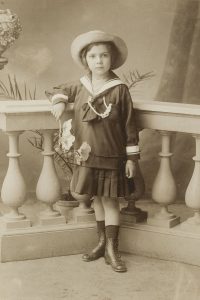 In Trieste, in 1915, Oscar de Mejo was a guest at the home of her cousin Leonor. The two were respectively four and eight years old.
In Trieste, in 1915, Oscar de Mejo was a guest at the home of her cousin Leonor. The two were respectively four and eight years old.
Oscar wanted to play with Lolò doll and took it away, kicking her cousin. Feeling guilty, seeked her forgiveness: “Lolò will you forgive me?”.
She did not reply. He observed her. Leonor was leafing through a book lying on her canopy bed. Oscar was curious and slowly approached her. She saw him and began to show him the illustrations in black and white: they were fearful drawings of a man being quartered. Lolò says: “I will too.” Oscar was puzzled and replies: “Will you hurt people?“, And she laughing: “No stupid! Maybe who knows … I wanted to say that, as an adult, I will do the painter, the artist. “(From the Roberto Curci’s book “I married Alida Valli”).
Oscar was described as a shy boy, well-mannered, trembling and quiet with a little face of angel; Leonor casual, ill-educated, inconstant, rebellious, capricious. A terrible little girl, according to the grandparents Braun. The mom, Instead, gave her all freedom and was proud of this daughter a little rebellious, which according to her became an important woman.
Even as a child Leonor proved be interested in the tricks, in the act of disguise: took the grandmother’s wigs, the masks of past Carnivals, the Mother’s make up. Disassembled and reassembled the dolls at will, doing their makeup and dressing them in a strange way, in clothes that she herself realized; She took out books from the library of his grandfather, she browsed the many. They were art books by Piero della Francesca, Paolo Uccello, Pisanello and remained fascinated.
 Around thirteen Leonor – as recalled in her autobiography – thanked to guard bringing her in the “deposit” – which was called the morgue – she could see the dead: the first saw was a certain “Mario La Vita.”
Around thirteen Leonor – as recalled in her autobiography – thanked to guard bringing her in the “deposit” – which was called the morgue – she could see the dead: the first saw was a certain “Mario La Vita.”
She did not like a lot the school: was repeatedly ejected. It was very undisciplined and one year, to be readmitted, had to give the all subjects exams. She was sent, during the summer, to study in Carnia, where she met a group of officials that carried her around – and so, no study, almost.
Back in Trieste participated in a dance in Opicina, but not having so much fun, he decided to go out: go to the show where she had fun with the attractions and having taken a lot of air on the face, the next day she found herrself with serious eye problems, which force her, for a long period, to bring the bandages which did not allow her to draw. Thanks to this adverse event, managed to be promoted without any examination.
At fifteen she began to paint and draw in a serious way: was dedicated to portraits, and became a friend of Arturo Nathan, an exceptional man who saw every day and that showed up at her house to talk also in the morning. She painted on herself, initially, and attended in Trieste eminent people and the artists Carlo Sbisà and Arturo Nathan himself, while Edmondo Passauro became her teacher. In the book “Fragments of memory. Intermittent notebooks”, the art critic Grillo Dorfles recalls:
“More opportunities for meetings and discussions took place then in the very hospitable Elsa Dobra’s house: a lady of good bourgeoisie, sister of the Élodie Stuparich who was one of three inspirers of Scipio Slataper and in whose salon gathered very often the dramatis personae of the strange comedy of art constituted by the intelligencijia of Trieste of thirties years: among others, Gerti Tolazzi, the philosopher and Arti Nathan pictor, the “Frombolo” Gruber (Silvio Benco daughter), Leonor Fini, who in those years had painted a beautiful portrait of Italo Svevo; and in addition to me and to Bobi, other characters now vanished into thin air of remembrance.”
One day, a lady visited the house of Leonor; she told her mother that a relative of her (Mario Alberti) had seen from them a portrait of Judge Alberti (brother of Mario), and that this portrait liked him a lot; the painter who painted it, could have come to Milan, to portray her entire family? So Leonor, the painter who did that painting, went not yet eighteen in the Lombard capital: in the station nobody waited for her, all waiting for a painter, and not a girl.
In January of 1929, in Milan – already since 1924 Leonor frequented this city, but she moved permanently only in that year – at the “Galleria Milano “, Lolò made her first real exposure. The hall was directed by Vittorio Barbaroux who had the courage to accept in its renowned Milanese gallery the production of three unknown artists from Trieste: Leonor Fini, Carlo Sbisà and Arturo Nathan said Arti – both great friends of Lolò with whom she spent her days in the inns of Carso, which reached riding her two friends motorcycles. Oscar de Mejo, after so long, met at the show the cousin, and was fascinated by her paintings: curious, different, suspended between reality and dream – close to Surrealism. Leonor, on this occasion, told the cousin to push her to move permanently to Milan was the furious reaction of the wife of her first painting teacher (probably Edmondo Passauro):
“Well, this hag raided in the study, and performed in a furious jealousy row. One unpleasant, unbearable thing.”
“But you were working, no?”
“Well … yes. Also …”
“I get it.”
(From the Roberto Curci’s book: “I married Alida Valli”)
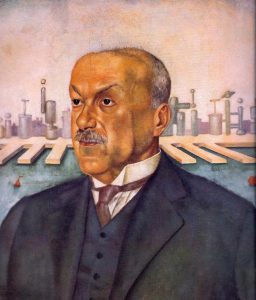 Displayed at the show there is also a Lolò painting portraying Italo Svevo elder. Leonor knew him well, because he is one of the many men of culture who attended the grandparents Braun and the uncle Braun. At home of her grandparents, Leonor also knew the poet Umberto Saba and Bazlen. In addition, there was also exhibited a work that depicted Linuccia Saba – the daughter of the poet.
Displayed at the show there is also a Lolò painting portraying Italo Svevo elder. Leonor knew him well, because he is one of the many men of culture who attended the grandparents Braun and the uncle Braun. At home of her grandparents, Leonor also knew the poet Umberto Saba and Bazlen. In addition, there was also exhibited a work that depicted Linuccia Saba – the daughter of the poet.
In that same year began to know a lot of people including Gio Ponti that commissions twelve drawings from her for the magazine “Domus”. Also during this period she met the painters Mario Sironi and Achille Funi; with the latter established a relationship and even attended his school of painting. The dream of Leonor was to return to Paris – where she settled there in the early thirties – where there was already been with her mother and where she had made a sketch book.
The second time she went to Paris to be alone there: met the painter de Pisis by train, with which she exchanged a few words. Arrived in the French capital, de Pisis brought her to the café “Aux Deux Magots“, where – as Leonor remembers – the coffee was bad: a kind of broth.
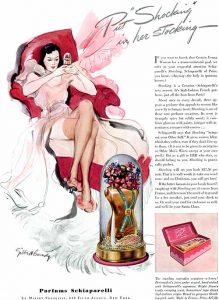 In 1931, Leonor permormed at the Galerie Bonjean – at 34 of rue de la Boétie – directed by Christian Dior – who at the time was not yet well known as fashion designer.
In 1931, Leonor permormed at the Galerie Bonjean – at 34 of rue de la Boétie – directed by Christian Dior – who at the time was not yet well known as fashion designer.
Lolò was dedicated to the female figure trying to discover the dark side of femininity. Research that lasted for a lifetime. In 1932, among the various paintings of women also appeared a male figure that brought attention to Leonor for portraits. The man in question was André de Pieyre Mandiargues – with whom she had a relation – who knew thanks to Henri Cartier-Bresson – the latter known shortly before in a Parisian pastry.
In 1933, Leonor approached the Surrealists through the friendship of the fashion designer Elsa Schiaparelli – for which realized, in 1938 the perfume bottle “Shocking” in the shape of a woman’s bust inspired by the body of Mae West, who then will be filmed, many years later, by Jean Paul Gaultier – who is introduced to her by Christian Dior. Always in the same year she met, at the home of Jacques Heim, Max Ernst.
In 1936, Leonor exhibited her paintings at the Julien Levy Gallery and at the Museum of Modern Art in New York. She was also present at the Exposition Surréaliste des Objets in Paris, at the International Exhibition of Surrealism in London, and at the Venice Biennale with five works.
When the Second World War was looming, in 1939, Leonor, Federico Veneziani and De Mandiargues leave – by invitation – to visit Max Ernst, at his home in Saint-Martin d’Ardèche. Ernst: “the charm of Leonor Fini is hidden behind the lines of her face: deep and magnetic eyes, of a black “bluish” . (“The theater subverted” by Vittoria Crespi Morbio)
I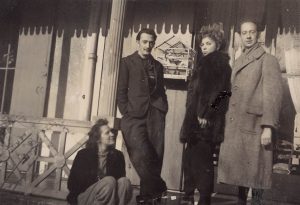 n 1939, with some of her friends she went to the border of Spain: to escape from the imminent war. They stopped in Arcachon, a place near the sea that had big dunes. Salvador Dalì – who lived nearby – leaved just after he heard that the enemy was coming. In 1940 Leonor returned to Paris before moving to Monte Carlo and avoid the German occupation of France.
n 1939, with some of her friends she went to the border of Spain: to escape from the imminent war. They stopped in Arcachon, a place near the sea that had big dunes. Salvador Dalì – who lived nearby – leaved just after he heard that the enemy was coming. In 1940 Leonor returned to Paris before moving to Monte Carlo and avoid the German occupation of France.
It was here that she married Federico Veneziani, with whom broke up shortly after, when, in 1941 met Stanislao Lepri – Italian Consul in the Principality of Monaco. He noted her in a cinematographe and immediately wanted to meet her. The two became friends and began to paint together. In 1943 she participated in the exhibition organized by Peggy Guggenheim on the advice of Duchamp in New York.
In the book “Una vita per l’arte. Confessioni di una donna che ha amato l’arte e gli artisti” Peggy Guggenheim remembers Leonor like that:
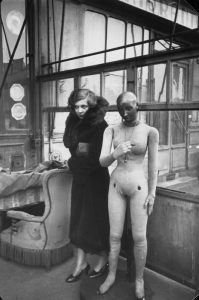 “Leonor Fini was the favorite of Max who came to visit us in Marseille soon after I was got rid of police. She always accused Max of having two Sophie instead of one, as Arp. In fact he had Leonora Carrington and Leonor Fini and tried in every way to give them a work. Fini was a very beautiful girl with a way of casually, she came from Monte Carlo, where he had taken refuge, and painted portraits for living. She wanted to see the new paintings of Max and brought it a little one, that had bought previously, after having seen in a photograph. Laurence, Marcel and I did not like that she seemed a leading woman pampered but Max adored her and wanted me just as I did: always seemed to ask me the approval of all. He introduced me to Fini as a patron of the arts, not as a lover, and I am sure that he wanted hide this fact. The painting that Fini brought with her was a charming little item. It looked like a postcard and later, in New York, Breton opposed to its inclusion in my collection, but because of Max could did not make anything.
“Leonor Fini was the favorite of Max who came to visit us in Marseille soon after I was got rid of police. She always accused Max of having two Sophie instead of one, as Arp. In fact he had Leonora Carrington and Leonor Fini and tried in every way to give them a work. Fini was a very beautiful girl with a way of casually, she came from Monte Carlo, where he had taken refuge, and painted portraits for living. She wanted to see the new paintings of Max and brought it a little one, that had bought previously, after having seen in a photograph. Laurence, Marcel and I did not like that she seemed a leading woman pampered but Max adored her and wanted me just as I did: always seemed to ask me the approval of all. He introduced me to Fini as a patron of the arts, not as a lover, and I am sure that he wanted hide this fact. The painting that Fini brought with her was a charming little item. It looked like a postcard and later, in New York, Breton opposed to its inclusion in my collection, but because of Max could did not make anything.
Max thought it was wonderful just because he had painted the Fini, as later judged stupendous anything of a young and talented girl who maybe admired. With male painters he was not so forgiving.”
Also in 1943, Lepri was recalled to Rome by the Italian authorities for the armistice and Leonor follows him. As soon as she arrived in the Italian capital saw through the streets images of Mussolini burn; Leonor remaind fascinated by the wonderful architecture of the palaces and huge flames.
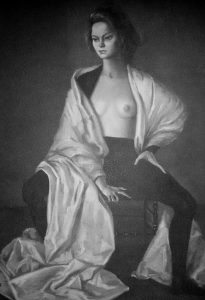 That day the British began to bomb Rome. Leonor took some of her paintings, and the two cats she had with herself and she went into shelters. She wanted to stay in Rome no longer and then went first to Santo Stefano and then to Isola del Giglio – even there, soon, the Germans arrived: Leonor went back again to Rome, where in 1944 her cousin Oscar de Mejo introduced to her his future wife, Alida Valli. Alida and Leonor were two completely different women: night and day.
That day the British began to bomb Rome. Leonor took some of her paintings, and the two cats she had with herself and she went into shelters. She wanted to stay in Rome no longer and then went first to Santo Stefano and then to Isola del Giglio – even there, soon, the Germans arrived: Leonor went back again to Rome, where in 1944 her cousin Oscar de Mejo introduced to her his future wife, Alida Valli. Alida and Leonor were two completely different women: night and day.
Despite their diversity, Leonor proposed to Alida to paint her a portrait; she accepted. The result was a pain that did not stress the actress’ radiance, but rather made her a bit disquieting.
Lolò lived on the top floor of Palazzo Altieri together with Stanislao Lepri. Her studio had a view of Piazza del Gesù and it was full of frescoes, which Alberto Savinio described as “not working air you breathe in this place. Just as it is entirely absent the smell of the materials used by the artist, it means paints and varnishes. The paintings of Leonor Fini mingle with the furniture, the objects, the tissues of this salon seamless, as if paintings and objects and furniture were trees of a same forest (Godard J. “Leonor Fini. Le realtà possibili”, 1998)”
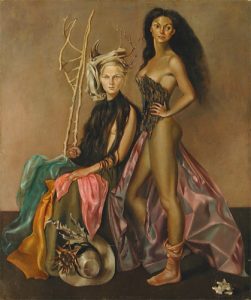 In 1946 Leonor returned to Paris where she resumed doing exhibitions and in addition was also dedicated to the theater, creating sets, costumes for known directors such as Genet, Strehler; she made some cat-like masks filled with pearls, rhinestones, embroideries, which were worn by both her than by others. And this theatre activity lasted for about twenty years. Leonor in 1948 portraied Joy Brown with classical dance Margot Fonteyn, who, in her “Autobiogrphy” recalled:
In 1946 Leonor returned to Paris where she resumed doing exhibitions and in addition was also dedicated to the theater, creating sets, costumes for known directors such as Genet, Strehler; she made some cat-like masks filled with pearls, rhinestones, embroideries, which were worn by both her than by others. And this theatre activity lasted for about twenty years. Leonor in 1948 portraied Joy Brown with classical dance Margot Fonteyn, who, in her “Autobiogrphy” recalled:
“We were all in feverish excitement for orchestra rehearsals and costumes of” Demoiselles “(Demoiselles de la Nuit taken from the story of Jean Anouilh n.d.s). Leonor Fini, the designer had an obsession with cats and made a perfect cat-like mask complete of pink nose, mustache and all. The problem was that I could not conceive of express something with the head locked in a box-cat. A love duet was out of the question. I felt grotesque. Leonor Fini was not prepared to modify the design, and I suddenly found myself shouting hysterically in French that I absolutely refused to wear the mask. I was horrified! I could not imagine doing such a thing at London’s Covent Garden! But it has worked, and the mask size has been reduced in a way to cover the eyes and a little nose, and remained the mustache. After all, my two costumes for the ballet were lovely. […]
Leonor had designed the setting of a sensationally realistic roof, and when all of us were chasing each other, above the tiles, the structure has collapsed.”
After a trip to Egypt with Lepri, in 1951 she returneed to Italy and participated in a masquerade party at the Palazzo Labia (Venice) where the photographer Ostier captured her disguised as a black angel.
In 1952 Leonor began the story with the Polish writer Costantin Jelenski – who had known in Rome through the brother of him, Sforzino Sforza, one of the many men of Leonor – but also continuing the relationship with Stanislao Lepri, accepting the menagé à trios.
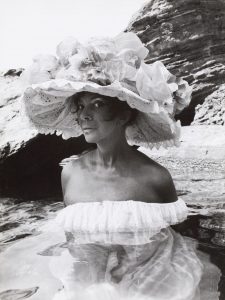 Driving around Corsica, during a trip with the two, Leonor saw in Nonza, near the sea, some ruins: they got out of the car and, by foot, went to see what it is. They find a Franciscan monastery. They decided to take it to them and restructure, turning it into a habitable house, in a heavenly place. For twenty-three summers (1954-1977) went there to relax, paint and do some “theatrical” performance in the company of friends. Among the patrons of this monastery there were Andy Warhl, Elsa Morante, Federico Fellini, Jean Genet. The three also organized theme parties on the colors and it was in the photos, which were taken in this period, which showed the love that Leonor had for the disguise and fabrics. “The fabrics for me have a spell, a force of attraction that must try the Tarantolati “(Le livre de Leonor Fini, 1975)
Driving around Corsica, during a trip with the two, Leonor saw in Nonza, near the sea, some ruins: they got out of the car and, by foot, went to see what it is. They find a Franciscan monastery. They decided to take it to them and restructure, turning it into a habitable house, in a heavenly place. For twenty-three summers (1954-1977) went there to relax, paint and do some “theatrical” performance in the company of friends. Among the patrons of this monastery there were Andy Warhl, Elsa Morante, Federico Fellini, Jean Genet. The three also organized theme parties on the colors and it was in the photos, which were taken in this period, which showed the love that Leonor had for the disguise and fabrics. “The fabrics for me have a spell, a force of attraction that must try the Tarantolati “(Le livre de Leonor Fini, 1975)
In 1977, Lepri feels bad and even Leonor does not enjoy good health, so leave that magical place with the awareness to never come back. Lepri, in fact, became seriously ill; he will die a few years later. Leonor continues to live in Paris, to paint, to exhibit his works and illustrate books: in the sixties Leonor Fini is now well known in Paris environment at the time and even beyond.
In the book “My Life with Dalí. Fifteen years of living together with the surrealist genius”, Amanda Lear remembers her meeting with Leonor:
[…] We took place in his Cadillac [of Dalì] to go to Ledoyen, a large restaurant at the Petit Palais on the Champs Elysées. […] Leonor Fini, with her personal court, joined us. In its way she was as extravagant as Dalì. Only her shoes sticking out from long dress, on which she wore a cape like those of the magicians. She had the stars in her hair and in one hand she held a wand like a scepter. It was obvious that she wanted to know who I was.
I saw Dalì reaching out to her and talk to her quietly. They were talking about me and Leonor Fini did not take her eyes off me, nodding occasionally as a sign of approval. Dalì told me later that she liked women, something I had already guessed. He added that her house was full of cats. She invited us to dinner for the following week and insisted that Dalì would bring me too.
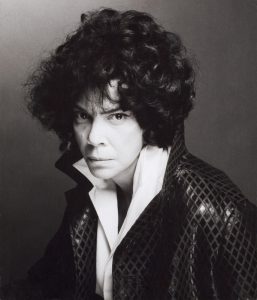 In the seventies, Leonor is dedicated to writing novels and her stories took on a very original character as her paintings are. Among her written works include: Mourmour, Count pour enfants velus (1976) – that is “Murmur. Fairy Tale for hairy children”, recently translated into Italian by Corrado Premuda – the Oneiropompe (1978) and Rogomelec (1979) – a sort of very romanticized autobiography, where Leonor took the form of a cat to tell herself.
In the seventies, Leonor is dedicated to writing novels and her stories took on a very original character as her paintings are. Among her written works include: Mourmour, Count pour enfants velus (1976) – that is “Murmur. Fairy Tale for hairy children”, recently translated into Italian by Corrado Premuda – the Oneiropompe (1978) and Rogomelec (1979) – a sort of very romanticized autobiography, where Leonor took the form of a cat to tell herself.
A little side note on the first short novel by Leonor: Murmur, a work that Leonor begun writing in 1968 in Nonza inspired by the nature of the Corsican coast and the abandoned monastery in which spended her summers. In this text we saw her great interest in the animal world, particularly in the cat figure: the protagonist was precisely half man, half cat. A story with a strong surrealistic character as is most of her paintings.
Her love for writing was also evident from the enormous quantity of letters that Leonor wrote to friends.
Daily devoted two hours to her personal correspondence: in her letters Leonor told emphatically about private facts, thoughts, opinions and her descriptions of people and events are full of details.
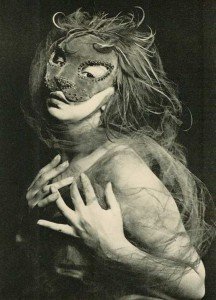 In Elsa Morante‘s letters (“The beloved. Letters to and by Elsa Morante“) there was a long correspondence with Leonor Fini, where most of the time, their cats were the main subject – they both had many and worship them. Also the actress Anna Magnani – that Leonor knew during her stay in Rome – loved cats. In fact all three were called “The cat ladies”.
In Elsa Morante‘s letters (“The beloved. Letters to and by Elsa Morante“) there was a long correspondence with Leonor Fini, where most of the time, their cats were the main subject – they both had many and worship them. Also the actress Anna Magnani – that Leonor knew during her stay in Rome – loved cats. In fact all three were called “The cat ladies”.
Moreover, as Leonor remembered in her autobiography, “the cat is the best mediator and the most accessible between us and nature.”
So Lolò was so interested in the animal side who even masqueraded as feline; many are her works that portraied “les chats”, the small furry four-legged friends that she loved so much.
Elsa and Leonor wrote them frequently and they told to the behavior of their cats, they spoke of reviews on some Italian newspapers which offended the figure of Leonor, they wrote of their vacation, new people that meet, the few valid riends that had and their works. In addition, Elsa Morante dedicated some poems to Leonor and also maintained a personal correspondence with Kot (Costantin Jelenski) and Lepre (Stanislao Lepri).
 In a letter of 1952, Elsa Morante wrote to Leonor: […] Now my cat G. (I know you do not like its name Giuseppe, but he wanted to be called like that) for two months it is no longer in the closet that you hated so much. I took it with me in my studio, and I started with it (this capital does tell you that G. is the angel of all the cats in the world) that our union that it was over when it preferred the cat Pamela to me.
In a letter of 1952, Elsa Morante wrote to Leonor: […] Now my cat G. (I know you do not like its name Giuseppe, but he wanted to be called like that) for two months it is no longer in the closet that you hated so much. I took it with me in my studio, and I started with it (this capital does tell you that G. is the angel of all the cats in the world) that our union that it was over when it preferred the cat Pamela to me.
While, at the end of a letter of 1954, Leonor Fini wrote to Elsa: Your cats also stick their tongues out when scratch their back?, confirming a vision of the animals of her own: “I always thought that the attributes of humans are very limited, very limited. I always envied the beasts, their hard, adequate claws, their resonant hooves, their glittering, phosphorescent flakes, heir deep mantle – especially their horns “(Le livre de Leonor Fini, 1975)
Leonor was died on January 19, 1996 in Paris, at her home in rue de la Vrillière.
In the fall of 2014 the Municipality of Trieste dedicated the city garden of Boccaccio street to the artist.
Nadia Pastorcich © centoParole Magazine – reproduction reserved
[English translation: Valeria Dissegna]

